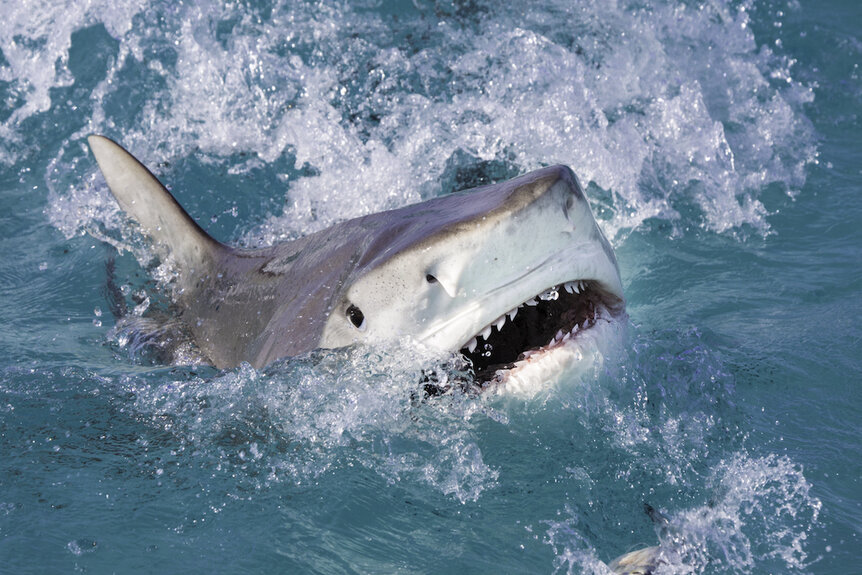Create a free profile to get unlimited access to exclusive videos, sweepstakes, and more!
Hawaiian surfer in good spirits after surviving tiger shark attack
Despite what the tagline to Jaws 3 might say, it isn’t personal.

The place is Amity Island, New England. The year is 1970-something. And the corpse of Chrissie Watkins just washed up on shore. Injuries on her body suggest significant trauma, maybe an animal, maybe an accident. The cautious course is the right one, but the economics of beach towns prevail. Chrissie’s death is ruled an accident; her injuries caused by a close encounter with a boat propeller. Soon after, young Alex Kintner is killed in broad daylight and in the view of hundreds of beachgoers. He vanishes into the jaws of a killer. Amity’s chief of police, Martin Brody, soon heads into the water with oceanographer Matt Hooper and Sam Quint, a grizzled boat captain with a shark-shaped ax to grind. You know the rest.
Jaws practically invented the summer blockbuster and launched the career of one Steven Spielberg. It also contributed to a shift in perception about sharks, one which has led to a lot of unnecessary fear and a lot of dead sharks. Prior to the 20th century, most people didn’t think about sharks at all. It was only in the 1960s that fear of sharks began to swell and Jaws, both the novel and the movie, probably reinforced that fear, something both Spielberg and the novel’s author Peter Benchley came to regret.
RELATED: Steven Spielberg ‘truly’ regrets demonization of sharks and harmful sport fishing caused by ‘Jaws’
While shark attacks are uncommon and not something that even frequent beachgoers should spend too much time worried about, they do happen, as one surfer recently learned too well. Mike Morita is a 40-year veteran surfer from Hawaii, who was out looking to catch some early waves Easter morning, near Kewalo Basin. In addition to being a good surfing spot, the area also appeals to sharks looking for a quick bite, which meant that Morita and a tiger shark found themselves in the same place at the same time.
“I was lying on my board and then the shark grabbed onto my leg, and I could just feel the strength and power of it. The shark pulled me under twice. There was a point where the tail came by me and because the punching didn’t work, I kind of underhooked the shark’s body with my leg and my arm. That time, when I hit the gills, the shark let go,” Morita said, speaking to Good Morning America, from his hospital bed.
Morita quickly assessed his injuries and called to friends nearby in the water for help. They tied a tourniquet, pulled Morita onto another board, and towed him back to shore. EMS workers said he would have bled out before getting to shore were it not for that quick thinking, according to Morita. Instead, Morita is recovering and appears to be in good spirits, though he did lose his right foot as a result of the injuries. Morita’s children started a Go Fund Me to help cover Morita’s medical expenses. At the time of writing, they have raised $89,350 toward a $100,000 goal.
Morita’s relaxed demeanor and positive attitude is probably the right response (though, other emotions would be justified and understandable) to a tragic but incredibly uncommon shark attack. Precise populations numbers are unknown but there are hundreds of millions of sharks, maybe more than a billion, in the world’s oceans and almost none of them attack or even encounter people.
What are the odds of getting bitten in a shark attack?
In 2022, there were only 108 reported shark attacks globally. That number includes bites to boats, bites at public aquariums, and scavenging bites, among other atypical situations. Only 57 of the attacks were classified as “unprovoked bites,” what we typically think of as a shark attack, and only five of them were fatal. By comparison, people kill an estimated 100 million sharks every year and scientists estimate the global population of sharks and rays has declined 71% in the last 50 years. Looking at the numbers, it’s hard to make sharks out as the bad guys.
The likelihood of any one person being bitten is vanishingly low, but there are a few things that increase your odds of getting tagged. Swimming in waters around the United States is the number one way to increase your odds of getting tagged. Of the 57 reported unprovoked bites, 41 of them occurred in the U.S. It’s worth noting, of course, that there may be some reporting bias in the numbers.
RELATED: No males? No problem: Shark in all-female tank just gave birth to a daddy-free mini-jaws
Florida tops the U.S. charts with 16 reported bites in 2022. New York comes in second with eight reported bites and Hawaii had five. What you’re doing in the water also matters. In 2022, surfing and board sports accounted for 35% of attacks, second only to swimming and wading with 43%. That’s actually an unusual result. Surfing and board sports usually top the chart.
Data surrounding attacks by species of shark is harder to come by. Most of the time, the shark vanishes into the deep afterward. They aren’t sticking around for a mug shot, which means identifying an attacker must be done by the victim or witnesses in the heat of the moment. Surfers are likely more familiar with the identifying characteristics of various sea creatures, but that’s a big ask while you’re actively being eaten. It is sometimes possible to make identifications from teeth left in bite wounds or from the shape and nature of any injuries, but that’s not always reliable. It’s important to know that there is unavoidable noise in the data when talking about what sorts of sharks are most dangerous and which are less so. With that megalodon-sized grain of salt, tiger sharks are known to be aggressive. They are second only to great whites when it comes to reported attacks.
Morita happened to find himself inside the perfect storm of bad luck, on a surfboard, in Hawaii, in the vicinity of a tiger shark. Fortunately, his luck turned when it counted. “Thank God for my friends, who saved my life,” Morita said.
For more shark-flavored nightmares you don’t need to worry about in real life, catch Sharknado: Heart of Sharkness, streaming on Peacock!



























